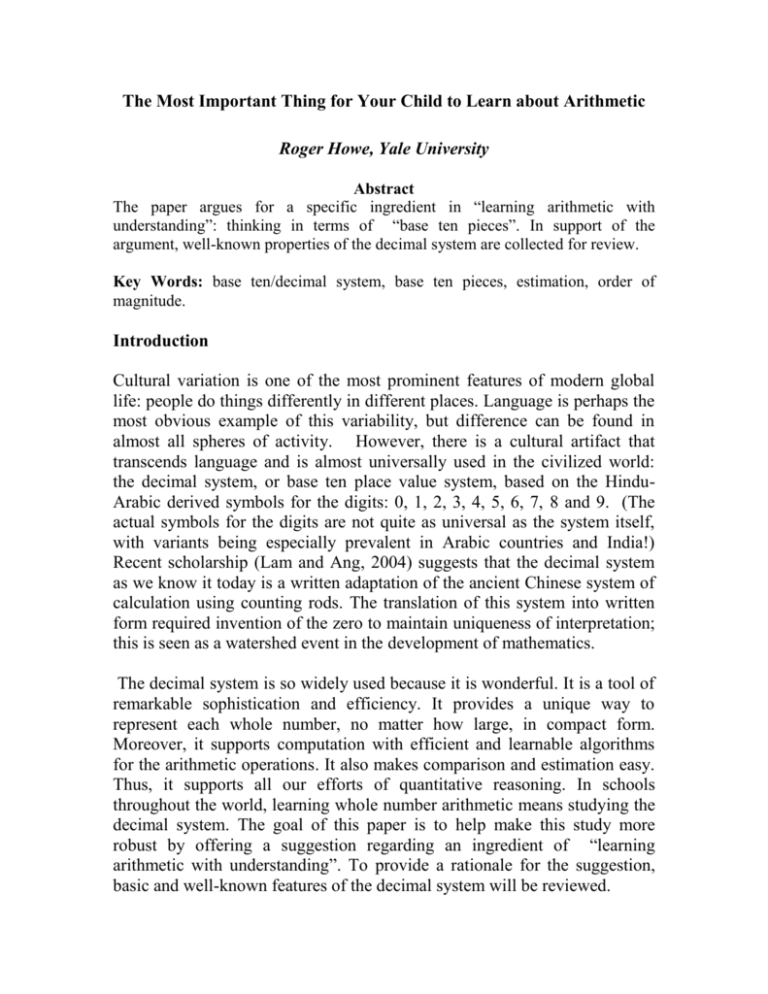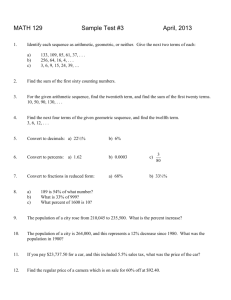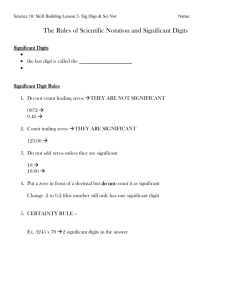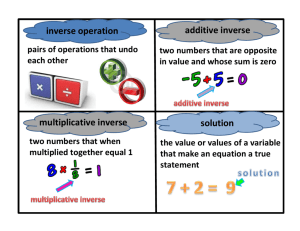The Most Important Thing for Your Child to Learn about Arithmetic
advertisement

The Most Important Thing for Your Child to Learn about Arithmetic Roger Howe, Yale University Abstract The paper argues for a specific ingredient in “learning arithmetic with understanding”: thinking in terms of “base ten pieces”. In support of the argument, well-known properties of the decimal system are collected for review. Key Words: base ten/decimal system, base ten pieces, estimation, order of magnitude. Introduction Cultural variation is one of the most prominent features of modern global life: people do things differently in different places. Language is perhaps the most obvious example of this variability, but difference can be found in almost all spheres of activity. However, there is a cultural artifact that transcends language and is almost universally used in the civilized world: the decimal system, or base ten place value system, based on the HinduArabic derived symbols for the digits: 0, 1, 2, 3, 4, 5, 6, 7, 8 and 9. (The actual symbols for the digits are not quite as universal as the system itself, with variants being especially prevalent in Arabic countries and India!) Recent scholarship (Lam and Ang, 2004) suggests that the decimal system as we know it today is a written adaptation of the ancient Chinese system of calculation using counting rods. The translation of this system into written form required invention of the zero to maintain uniqueness of interpretation; this is seen as a watershed event in the development of mathematics. The decimal system is so widely used because it is wonderful. It is a tool of remarkable sophistication and efficiency. It provides a unique way to represent each whole number, no matter how large, in compact form. Moreover, it supports computation with efficient and learnable algorithms for the arithmetic operations. It also makes comparison and estimation easy. Thus, it supports all our efforts of quantitative reasoning. In schools throughout the world, learning whole number arithmetic means studying the decimal system. The goal of this paper is to help make this study more robust by offering a suggestion regarding an ingredient of “learning arithmetic with understanding”. To provide a rationale for the suggestion, basic and well-known features of the decimal system will be reviewed. Basics of the Decimal System How does the decimal system accomplish its marvels? The secret is in the structure behind how it represents numbers. First, each base ten number is implicitly a sum: 352 = 300 + 50 + 2. Each number is represented as a sum of very special numbers. There seems to be no standard short name for these numbers1. In this article, we will just call them the “base ten pieces" of the number, or just “pieces" for short. Furthermore, and critically, the base ten pieces have multiplicative structure. The first part of this structure is, the digit for each base ten piece records the number of copies of a base ten unit that is used to create that number. Thus, 300 = 3×100, 50 = 5×10, 2 = 2 ×1. The numbers 1, 10 and 100 are the base ten units, and the digit multiplying each unit tells how many copies of that unit are used to compose the number. The symbol for the number, 352, indicates which unit is multiplied by which digit by the position of the digit. The rightmost digit, 2, tells the number of 1s needed; the next digit to the left, 5, tells the number of 10s needed, and the digit next to the left of that, the 3, tells how many 100s are needed. Thus, the size of the base ten unit corresponding to each digit is revealed by the position of the digit in the base ten representation. This of course is why the decimal system is called a positional, or place value system. To make this system work, it is essential to have a 0 -- a symbol representing nothing, so that if no copies of a particular base ten unit of a given size are needed to represent a given number, one can still write something in the corresponding place, which allows the digits representing larger base ten units to appear in the place corresponding to the correct unit. This principle is seen especially in the representation of the base ten pieces: 300 is made of 3 hundreds, 0 tens and 0 ones, and similarly, 50 is made of 5 tens and 0 ones. It is the 0s in the tens and ones places that signal to us that the number means what it does. Knowing that each special number is a digit times a base ten unit does not exhaust the multiplicative structure of the special numbers. The base ten units themselves stand in a multiplicative relationship to each other. The unit 1 To this author, this is a remarkable lacuna in the mathematics education literature. “ten” consists of 10 ones. It is 10×1. Likewise, the unit “hundred” consists of 10 tens: it is 10×10. And the next base ten unit, “thousand”, consists of 10 hundreds: it is 1,000 = 10×100. And so on, and so on, and so on. We can notice that the number of times we have multiplied by 10 to get a certain unit is the number of zeroes used in representing the unit. This is a happy side-effect of using positional notation, and it suggests the even more compact representation of larger numbers, by simply recording the number of factors of 10 that have gone into creating a given unit. Thus (not in elementary grades, but as part of the study of algebra), it is common to write 10 = 101, 100 = 10×10 = 102, 1,000 = 10×100 = 10×10×10 = 103, and so forth. We will call the power of ten that designates a given base ten unit the order of magnitude of that unit, or sometimes just the magnitude. Thus, there is a huge amount of structure built into the conventions of the decimal system. First, each number is a sum of special numbers. Each special number is a digit times a base ten unit. Which base ten unit a digit is multiplying is shown by the location of the digit in the base ten expression. Moreover, the base ten units themselves embody a multiplicative principle, which is called forming powers of the base of the system, i.e., 10. Making all this structure explicit reveals five stages of place value: 352 = 300 + 50 + 2 = 3×100 + 5×10 + 2×1 = 3× (10×10) + 5×10 + 2×1 = 3×102 + 5×101 + 2. The first stage is of course the standard form of writing numbers. The second is often mentioned in the early grades, under the name expanded form. It identifies and isolates the base ten pieces of the number. The next two stages make more explicit the multiplicative structure of the base 10 pieces. The third stage factors each piece into its digit times its base ten unit. The fourth stage exhibits the base ten units as products of several factors of 10, or as powers of 10. These might be called the second expanded form and the third expanded form. The fifth and final stage makes a connection with algebra: it reveals that base ten notation is a very compact way of representing numbers as “polynomials in 10". This point of view sheds light on the secret of the power of base ten representation: it is using all the structure of algebra -- addition, multiplication, and exponentiation -- simply to represent numbers. Arithmetic with Base Ten Numbers The structure of the base ten pieces and the base ten units has a remarkable consequence for computation: the sum or the product of an arbitrary pair of whole numbers can be found by combining calculations involving only two base ten pieces. Moreover, the calculations with the base ten pieces reduce to single digit calculations, combined with order of magnitude considerations. Space limitations do not allow a full description here. We will make a few basic observations, and refer to (Epp-Howe 2008) for details. The basis for performing addition with base ten numbers is the fact that, since every base ten unit is the same multiple (i.e., 10) times the next smaller unit (and because of the Rules of Arithmetic) addition of single digit multiples of any base ten unit behaves in the same way as addition of single digit numbers themselves: 2 + 5 = 7, and 20 + 50 = 70, and 200 + 500 = 700. And this remains true when the single digit sum is more than 10: 7 + 8 = 15, 7,000 + 8,000 = 15,000, and 700,000 + 800,000 = 1,500,000. This parallel structure of addition at all orders of magnitude gives rise to a simple method for finding the sum of any two base ten numbers. The key steps: i) Break each number into its base ten pieces. ii) Add each pair of pieces of the same order of magnitude. iii) Recombine the sums into a base ten number. Here is an example (with no regrouping; for that, see (Epp-Howe 2008)): 352 + 416 = 300 + 50 + 2 + 400 + 10 + 6 = 300 + 400 + 50 + 10 + 2 + 6 = 700 + 60 + 8 = 768. The recombinations here may seem complicated, but that is only on paper. From a mental point of view, this is very close to the standard algorithm. In fact, the standard algorithm can (and should!) be seen simply as an efficient way to juxtapose the digits of the same-size base ten pieces of the addends for convenient (columnwise) addition: 352 + 416 768 Multiplication also can be handled in a similar spirit: multiplication of any two numbers can be accomplished by suitable combinations of multiplications of their base ten pieces, which amount to single-digit multiplications, combined with products of base ten units. Here the decimal system provides huge value. Multiplication was a task left to experts before the introduction of the decimal system, but afterward, anyone could do it. The overall process is governed by the principle of Each With Each (EWE) (see (Epp-Howe 2009)): to multiply two sums, multiply each addend of one sum with each addend of the other, and sum all the products. For example: 352×416 = (300 + 50 = 300 × 400 + 50 × 400 + 2 × 400 + 2) × (400 + 10 + 6) + 300 ×10 + 300 × 6 + 50 ×10 + 50 × 6 + 2 × 10 + 2 ×6 = (3 × 4) × (100 × 100) + (3 × 1) ×(100 × 10) + (3 × 6) × (100 × 1) + (5 × 4) × (10 × 100) + (5 × 1) × (10 × 10) + (5 × 6) × (10 × 1) + (2 × 4) × (1 × 100) + (2 × 1) × (1 ×10) + (2 × 6) × (1 × 1) = 120,000 + 3,000 + 1,800 + 20,000 + 500 + 300 + 800 + 20 + 12. The product is found by adding all these 9 products of base ten pieces. The fine points of multiplication algorithms are devoted to organizing the sums. Estimation and Approximation Comparison and estimation can likewise be handled in terms of base ten pieces. It is important to note that comparison and estimation involve considerations of size, which is a very different matter from the operations of arithmetic. Although computation usually gets more attention in the curriculum, size is the most important aspect of numbers for most applications. So the fact that the decimal system handles size comparisons as cleanly, if not more so, than the arithmetic operations, is very valuable. For this discussion, we need to extend the term “order of magnitude" from base ten units to all numbers. We say that the order of magnitude of a base ten piece is the same as the order of magnitude of the base ten unit of which it is a (single-digit) multiple. And the order of magnitude of any whole number is the order of magnitude of its largest non-zero base ten piece. In other words, the order of magnitude is one less than the number of digits. The base ten units increase very rapidly in size as their order of magnitude increases: each unit is 10 times as large as the next smaller one! It is hard to keep this in mind without some effort. Many people do not distinguish strongly between a million and a billion, and think of them both as “very large numbers”. Of course they are, but there is a huge difference: a million is puny compared to a billion. And these days, to understand the U.S. budget, you have to deal with trillions. It may be helpful to think in terms of time. A thousand seconds is enough time to have a cup of coffee or a short lunch. A million seconds ago is 11 to 12 days -- the middle of last week. A billion seconds is over 30 years -- about half a lifetime. And a trillion seconds ago was the old Stone Age -- the pyramids of Egypt were far, far in the future, and Neanderthal people were roaming Europe. Since a base ten unit is 10 times as large as the next smaller one, and since in a base ten number, only multiples up to 9 are allowed of any unit, a single base ten unit is larger than any base ten number of smaller magnitude. This means that, for any base ten number and any order of magnitude, if we just delete all the base ten pieces smaller than that magnitude, we will of course get a smaller number; but if we delete all those smaller pieces, and add just one base ten unit of the given magnitude, we will get a larger number. The first procedure is called rounding down, and the second procedure is rounding up. Here are some examples: 350 < 352 < 360, 300 < 352 < 400. 37,340,000 < 37,344,192 < 37,350,000 It follows from this “sandwiching” type of relationship that there is a very simple criterion for comparing two base ten numbers. Given two of them, compare the base ten pieces, starting from the largest order of magnitude. Find the largest order of magnitude for which their base ten pieces are different. Then the number with the larger piece of this order of magnitude is the larger number. Here again are some examples. 416 > 400 > 352; 37,344,192 > 37,340,000 > 37,330,000 > 37,328,793. We can regard rounded versions of a base ten number as approximations to the number. There are many reasons for working with rounded numbers. First, they are simpler to deal with -- to write, to remember, to calculate with 1 -- since they have fewer pieces. Second, since each base ten unit is only as 10 large as the next larger one, the smaller base ten pieces contribute a rapidly smaller and smaller share of the whole number. For example, if we take the number 37,344,192, and round it down to various places, we find that the rounded number captures large percentages of the whole number, and that these percentages rapidly approach 100%. 30,000,000 > 80% of 37,344,192, 37,000,000 > 99% of 37,344,192, 37,300,000 > 99.8% of 37,344,192, and 37,340,000 > 99.98% of 37,344,192. You do not need very many of the larger base ten pieces before you have all of the number you can make practical use of. In many situations, just the leading piece will be enough. In most situations, the two leading places will be enough. In almost all situations, the three largest places will be all you need. In fact, for many quantities that you may work with, if they are reported to more than 3 base ten pieces, you should be suspicious, because the smaller pieces may well not have any basis in reality. This applies especially to figures derived using statistical methods. Consider population. It may seem a simple thing to count, but when the counting is of people, who are dying and being born and moving around, it is not. The population of even a medium sized city probably changes daily, in ways that can be difficult to keep track of. So any statement of population of a city or a state that claims to know the exact number of people there is a lie. Thus, it is both happy for us that the decimal system provides accurate approximations with so little effort, and it is incumbent on us, in this data driven, quantitative world, to understand both the limitations of accuracy with which we can know numbers, and to be sensitive to the accuracy that base ten numbers provide. We should not use more digits than our knowledge supports. Reporting numbers to too many digits is one of the more pervasive forms of innumeracy. The Moral What should the student of mathematics take away from this discussion? We have seen that the basic principle of base ten notation is to decompose any whole number into special numbers, its base ten pieces. We have also seen that this structure is highly compatible with computation, and with estimation and approximation. Moreover, an arbitrary number can be expressed with high relative accuracy using only a few of its largest base ten pieces. In particular, the overall size of a number is well captured by just its largest base ten piece. Moreover, for many measurements, expressing the results with more than 2 or 3 pieces does not make sense. The moral of this story is: the most important thing a student of arithmetic can learn is to think in terms of the pieces. It is to be distinguished from thinking in terms of the digits. Indeed, it is possible to deal with arithmetic in terms of formal manipulations of the digits, and many students, including prospective teachers, end up doing this (Kamii, 1986, Thanheiser, 2009). However, the digits do not convey the size information that is an essential aspect of the pieces, neither the absolute size nor the relative size, and size is the main information we are seeking when we work with numbers. Understanding the base ten pieces as quantities of particular (and quite different) sizes, and working with those quantities in terms of their size, is key to understanding arithmetic. It would include routinely mentally breaking up numbers into their expanded form, understanding the nature of each piece, and doing estimation of sums and products using mental math with the two largest pieces. Also, by relating the units of various sizes to powers of 10, students should be much more ready to deal with decimal fractions and polynomial arithmetic. Unfortunately, space does not permit discussing teaching for this way of thinking. See (Howe, 2010) for some ideas for first grade. It would also include systematically discussing the 5 stages of place value at appropriate places throughout the elementary curriculum. The study (Yang-Cobb, 1995) is consistent with the claim that thinking in terms of the pieces promotes learning, and provides examples of real-world implementation. Your children should learn to think in terms of the pieces. References Epp, S. & Howe,R. (2008) Taking Place Value Seriously. On the web at: http://www.maa.org/sites/default/files/pdf/pmet/resources/PVHoweEpp -Nov2008.pdf Howe, R. (2010) Three Pillars of First Grade Mathematics. On the web at e.g: http://commoncoretools.me/2012/02/08/article-by-roger-howe-three-pillars-of-firstgrade-mathematics/ Kamii, C. (1986) Place value: An explanation of its difficulty and educational implications for the primary grades, J. Res. Math. Ed. 17, 75 - 86. Lam, L. and Ang, T. (2004). Fleeting Footsteps, New Jersey, etc: World Scientific. Yang,M. & Cobb,P. (1995) A Cross-Cultural Investigation into the Development of Place Value Concepts of Children in Taiwan and the United States, Ed. Stud. Math. 28, 1 – 33. Thanheiser, E. (2009). Preservice Elementary School Teachers' Conceptions of Multidigit Whole Numbers. J. Res. Math. Ed. 40, 251 - 281.







![[#SOL-138] Convert hexadecimal values to a decimal](http://s3.studylib.net/store/data/007771276_2-599dfe3c9f164501ba227b84b075bcb7-300x300.png)
